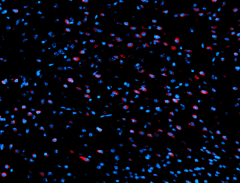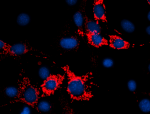- Clone
- W19053A (See other available formats)
- Regulatory Status
- RUO
- Other Names
- Wingless-Type MMTV Integration Site Family, Member 7A (WNT7A), Wnt Family Member 7A, Proto-Oncogene Wnt7a Protein, Protein Wnt7a
- Isotype
- Rat IgG2a, κ
- Ave. Rating
- Submit a Review
- Product Citations
- publications

-

IHC staining of purified anti-Wnt7a antibody (clone W19053A) on formalin-fixed paraffin-embedded mouse brain tissue. The tissue was incubated with 5 μg/mL of the primary antibody overnight at 4°C, followed by incubation with 2.5 μg/mL of Alexa Fluor® 594 goat anti-rat IgG antibody (yellow) (Cat. No. 405322) for one hour at room temperature. Nuclei were counterstained with DAPI (blue), and the slide was mounted with ProLong™ Gold Antifade Mountant. The image was captured with a 20x objective. -

ICC staining of purified anti-Wnt7a antibody (clone W19053A) and NIH-3T3 cells were resolved with 4% PFA, and permeabilized with 100% ice-cold methanol. Cells were then blocked with 5% fetal bovine serum in PBS for 30 minutes, and then incubated with 5 µg/mL of the primary antibody overnight at 4°C, followed by incubation with 2.5 µg/mL of Alexa Fluor® 594 goat anti-rat IgG antibody (red) (Cat. No. 405422) for one hour at room temperature. Nuclei were counterstained with DAPI (blue), and the slide was mounted with ProLong™ Gold Antifade Mountant. The image was captured with a 40X objective.
| Cat # | Size | Price | Quantity Check Availability | Save | ||
|---|---|---|---|---|---|---|
| 949501 | 25 µg | 95€ | ||||
| 949502 | 100 µg | 235€ | ||||
The WNT protein family has a highly conserved cysteine-rich structure that associates with the extracellular matrix (ECM) with high affinity through binding to heparin sulfate glycoproteins. They are carried intercellularly by lipoproteins and mediate signaling activity by binding to transmembrane Frizzled receptors and low-density-related proteins (LRP). They elicit a variety of responses through canonical or non-canonical (PCP or Ca2+) pathways. There are two subtypes of WNT7 that have been identified, WNT7a and WNT7b.
WNT7a is a secreted cell-surface signaling protein that controls a set of pathways that act on cell fate determination and tissue patterning during embryogenesis. It is known that WNT7a can modulate the development of the uterus, cerebellum and limbs, while WNT7b is important in lung and placental development. The human amino acid sequence of WNT7a shares high similarity (99.4%) with mouse WNT7a. Signals transduced through WNT7a and its receptor are critical for female organ development, maintaining levels of female sex hormones and the development of oviduct and uterus. Receptors for WNT7a include frizzled-5, frizzled-7 and frizzled-10. WNT7a binds to frizzled-7 to induce signaling through the SKT/mTOR pathway in order to further modulate myofibers in a G-protein dependent PI3K pathway.
During muscle cell regeneration, WNT7a in the ECM along with transiently raised fibronectin levels in the stem cell niche can bind the frizzled-7/Sdc4 receptor complex and synergistically induce symmetric divisions of satellite stem cells. Also, in neurogenesis and chondrogenesis, WNT7a contributes to regulating and maintaining the level of lineage differentiation factors required to promote apoptosis/cell death through the binding of different receptors and interactions with ECM proteins.
Product Details
- Verified Reactivity
- Mouse
- Antibody Type
- Monoclonal
- Host Species
- Rat
- Immunogen
- Partial recombinant mouse Wnt7a protein
- Formulation
- Phosphate-buffered solution, pH 7.2, containing 0.09% sodium azide
- Preparation
- The antibody was purified by affinity chromatography.
- Concentration
- 0.5 mg/mL
- Storage & Handling
- The antibody solution should be stored undiluted between 2°C and 8°C.
- Application
-
ICC - Quality tested
IHC-P - Verified - Recommended Usage
-
Each lot of this antibody is quality control tested by immunocytochemistry. For immunocytochemistry, a concentration range of 2.5 - 5.0 μg/mL is recommended. For immunohistochemistry on formalin-fixed paraffin-embedded tissue sections, a concentration range of 2.5 - 5.0 µg/mL is suggested. It is recommended that the reagent be titrated for optimal performance for each application.
- Application Notes
-
For ICC fix/perm, use 100% methanol or 4% PFA followed by 100% methanol. It is not recommended for western blotting. Cross-reactivity versus other Wnt family members were not tested.
- RRID
-
AB_2910517 (BioLegend Cat. No. 949501)
AB_2910517 (BioLegend Cat. No. 949502)
Antigen Details
- Structure
- Wnt7a is 349 amino acid protein with a predicted molecular mass of ~39 kD.
- Distribution
-
WNT7a is expressed in the placenta, kidney, testis, uterus, fetal lung, fetal and adult brain.
- Function
- WNT7a is important for dorsal ectoderm tissue development and regulation.
- Interaction
- Binding of Wnt7a with Frizzled receptors (Fzd5, Fzd7, Fzd10) induces activation of Disheveled 1 (Dvl1), which stimulates downstream effector pathways mediated by e.g. the small GTPases RhoA and Rac1, along with CamKII.
- Ligand/Receptor
- Frizzled receptors, LRP co-receptors.
- Molecular Family
- Growth Factors, Neurotrophic Factors
- Antigen References
-
1. Barclay AN, et al. 1997. The Leukocyte Antigen FactsBook Academic Press.
2. Haynes BF, et al. 1991. Cancer Cells 3:347.
3. Goldstein LA, et al. 1989. Cell 56:1063.
4. Mikecz K, et al. 1995. Nat. Med. 1:558.
5. Hegde V, et al. 2008. J. Leukocyte Biol. 84:134.
6. Liu T, et al. 2009. Biol. Direct 4:40. - Gene ID
- 22421 View all products for this Gene ID
- UniProt
- View information about Wnt7a on UniProt.org
Related Pages & Pathways
Pages
Related FAQs
Other Formats
View All Wnt7a Reagents Request Custom Conjugation| Description | Clone | Applications |
|---|---|---|
| Purified anti-Wnt7a Antibody | W19053A | ICC,IHC-P |
Compare Data Across All Formats
This data display is provided for general comparisons between formats.
Your actual data may vary due to variations in samples, target cells, instruments and their settings, staining conditions, and other factors.
If you need assistance with selecting the best format contact our expert technical support team.
 Login / Register
Login / Register 









Follow Us